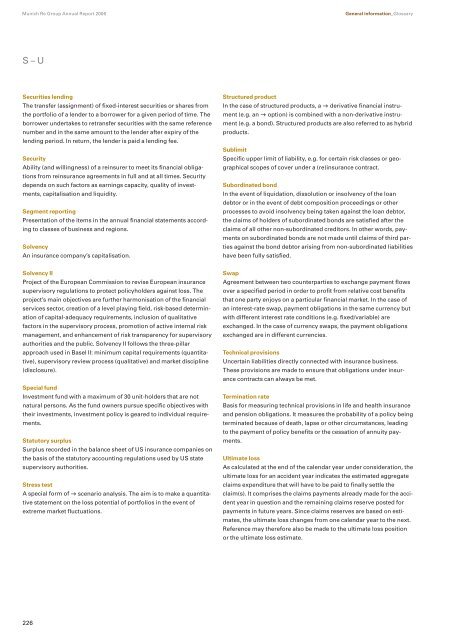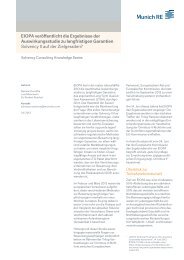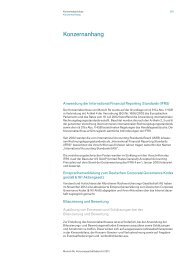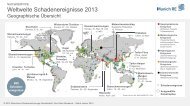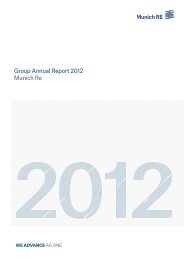Munich Re Group Annual Report 2006 (PDF, 1.8
Munich Re Group Annual Report 2006 (PDF, 1.8
Munich Re Group Annual Report 2006 (PDF, 1.8
Create successful ePaper yourself
Turn your PDF publications into a flip-book with our unique Google optimized e-Paper software.
<strong>Munich</strong> <strong>Re</strong> <strong>Group</strong> <strong>Annual</strong> <strong>Re</strong>port <strong>2006</strong> General information_Glossary<br />
S – U<br />
Securities lending<br />
The transfer (assignment) of fixed-interest securities or shares from<br />
the portfolio of a lender to a borrower for a given period of time. The<br />
borrower undertakes to retransfer securities with the same reference<br />
number and in the same amount to the lender after expiry of the<br />
lending period. In return, the lender is paid a lending fee.<br />
Security<br />
Ability (and willingness) of a reinsurer to meet its financial obligations<br />
from reinsurance agreements in full and at all times. Security<br />
depends on such factors as earnings capacity, quality of investments,<br />
capitalisation and liquidity.<br />
Segment reporting<br />
Presentation of the items in the annual financial statements according<br />
to classes of business and regions.<br />
Solvency<br />
An insurance company’s capitalisation.<br />
Solvency II<br />
Project of the European Commission to revise European insurance<br />
supervisory regulations to protect policyholders against loss. The<br />
project’s main objectives are further harmonisation of the financial<br />
services sector, creation of a level playing field, risk-based determination<br />
of capital-adequacy requirements, inclusion of qualitative<br />
factors in the supervisory process, promotion of active internal risk<br />
management, and enhancement of risk transparency for supervisory<br />
authorities and the public. Solvency II follows the three-pillar<br />
approach used in Basel II: minimum capital requirements (quantitative),<br />
supervisory review process (qualitative) and market discipline<br />
(disclosure).<br />
Special fund<br />
Investment fund with a maximum of 30 unit-holders that are not<br />
natural persons. As the fund owners pursue specific objectives with<br />
their investments, investment policy is geared to individual requirements.<br />
Statutory surplus<br />
Surplus recorded in the balance sheet of US insurance companies on<br />
the basis of the statutory accounting regulations used by US state<br />
supervisory authorities.<br />
Stress test<br />
A special form of scenario analysis. The aim is to make a quantitative<br />
statement on the loss potential of portfolios in the event of<br />
extreme market fluctuations.<br />
226<br />
Structured product<br />
In the case of structured products, a derivative financial instrument<br />
(e.g. an option) is combined with a non-derivative instrument<br />
(e.g. a bond). Structured products are also referred to as hybrid<br />
products.<br />
Sublimit<br />
Specific upper limit of liability, e.g. for certain risk classes or geographical<br />
scopes of cover under a (re)insurance contract.<br />
Subordinated bond<br />
In the event of liquidation, dissolution or insolvency of the loan<br />
debtor or in the event of debt composition proceedings or other<br />
processes to avoid insolvency being taken against the loan debtor,<br />
the claims of holders of subordinated bonds are satisfied after the<br />
claims of all other non-subordinated creditors. In other words, payments<br />
on subordinated bonds are not made until claims of third parties<br />
against the bond debtor arising from non-subordinated liabilities<br />
have been fully satisfied.<br />
Swap<br />
Agreement between two counterparties to exchange payment flows<br />
over a specified period in order to profit from relative cost benefits<br />
that one party enjoys on a particular financial market. In the case of<br />
an interest-rate swap, payment obligations in the same currency but<br />
with different interest rate conditions (e.g. fixed/variable) are<br />
exchanged. In the case of currency swaps, the payment obligations<br />
exchanged are in different currencies.<br />
Technical provisions<br />
Uncertain liabilities directly connected with insurance business.<br />
These provisions are made to ensure that obligations under insurance<br />
contracts can always be met.<br />
Termination rate<br />
Basis for measuring technical provisions in life and health insurance<br />
and pension obligations. It measures the probability of a policy being<br />
terminated because of death, lapse or other circumstances, leading<br />
to the payment of policy benefits or the cessation of annuity payments.<br />
Ultimate loss<br />
As calculated at the end of the calendar year under consideration, the<br />
ultimate loss for an accident year indicates the estimated aggregate<br />
claims expenditure that will have to be paid to finally settle the<br />
claim(s). It comprises the claims payments already made for the accident<br />
year in question and the remaining claims reserve posted for<br />
payments in future years. Since claims reserves are based on estimates,<br />
the ultimate loss changes from one calendar year to the next.<br />
<strong>Re</strong>ference may therefore also be made to the ultimate loss position<br />
or the ultimate loss estimate.


